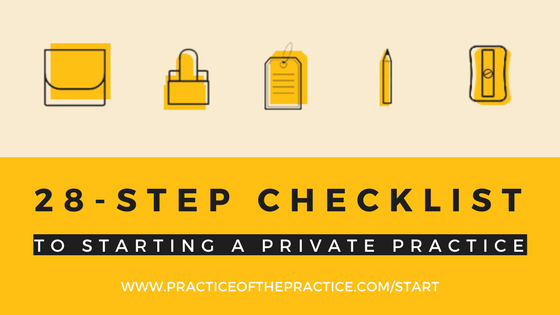Podcast: Play in new window | Download | Embed
In this episode, Joe Sanok speaks about how to find a specialty.
Podcast Sponsor
Confused by all the advice on starting a private practice? I’d love to help. I put together a checklist of the top 28 things to do to launch a private practice.
In This Podcast
Summary
If you are in private practice and are under the $60 000 mark, this podcast series is for you! Joe is going back to the basics and running through the various phases involved in setting up a practice that is going to thrive! In this episode, Joe speaks about the importance of specializing and how to figure out who your ideal client is.
Figuring Out Your Ideal Client
- Name
- Age
- Pains
- Connections
- “Imagine if …”
How To Specialize More
People will always assume that specialists are also generalists.
Useful Links:
Meet Joe Sanok
Joe Sanok helps counselors to create thriving practices that are the envy of other counselors. He has helped counselors to grow their businesses by 50-500% and is proud of all the private practice owners that are growing their income, influence, and impact on the world. Click here to explore consulting with Joe.
Thanks For Listening!
Feel free to leave a comment below or share this podcast on social media by clicking on one of the social media links below! Alternatively, leave a review on iTunes and subscribe!
Podcast Transcription
File: POP 258 – How to find a specialty
Duration: 0:08:56
[MUSIC]
This is the Practice of the Practice Podcast with Joe Sanok, session #258.
[MUSIC]
[INTRODUCTION AND A START]
Joe Sanok: Welcome. Welcome. Welcome. I am Joe Sanok, your host, and I am so glad that you’re here. We are all about innovative ways to start, grow, and scale private practices. If you are a counselor, massage therapist, chiropractor, doctor, any healthcare professional that has a private practice that you want to start, grow, and scale, you are in the right place. We have been mostly focusing on counselors in private practice. But we have been hearing a lot from people that are in general healthcare. We are not going to be moving away from counselors, but I am telling you, other folks are getting value from this podcast too. So if you are starting a practice, you are in the right place. You are with your people. You have found your tribe and I am so glad you are here. If you are new to the Practice of the Practice podcast, thanks so much for taking time, and if you think we are valuable, we would love to have a rating or review in iTunes. Also, as part of this series, if you are not part of the email list, the email list is more than an email list. It’s really a walk through to help you go from feeling overwhelmed, confused, unsure about how to best start a practice, to know that you are doing it right, to launch faster, to be organized, to get the best advice and tips quickly, so that you can just start this practice and start seeing clients. It’s totally free. Head on over to www.practiceofthepractice.com/start and you are going to get a 28-step checklist on exactly how to start a private practice. The best things that I use, a 5-minute video on how to evaluate practices in your community, and 13 emails that are going to be paste out and show you exactly what action you need to take. Each email ends with one action that’s going to walk you through starting your practice so that you can attract your ideal clients.
Well, today we are talking all about how to find a specialty. This is one of the most important things to think about. We talked the last time a little bit about how… you know… people if you are specialist, assume that you are also a generalist. And so if you are focusing on depression, if you are focusing on athletes, if you are focusing on high-end rich people that are dealing with substance use disorder. Whatever you focus is, they will also assume that you can do other things.
[FIGURING OUT YOUR IDEAL CLIENT]
And so starting with doing an exercise called identifying your business avatar or your ideal client is really important. So just take out a piece of paper, give this person this ideal client name. Maybe it’s Rachael, maybe it is Todd, maybe it’s Ben or Janet whatever you want to name him or her.
And then focus in on from there. What age do you think they are? What are they struggling with? Who they went to? And that’s going to really inform a lot of your copy. I was recently listening to a podcast where one of the writing techniques was, well, the average person will do these things and then you bullet point out. So the average person dealing with depression will have a hard time getting out of bed. At work, they may feel less productive. They may feel like just a sadness all the time. But imagine if you could feel better and that’s where you start to sketch out the imagine. Imagine if you could feel better. Imagine if you felt like you had a clear plan for exactly how it helped your mental health. Imagine if you had someone that was an expert in this area that walked you through something that has been proven time and time again. So you are sketching out for that person. I know what you are at. I know what most person at your phase go through. But imagine if things change. So my business avatar, one of them is people who are starting a practice. So most people starting a practice, they may listen to a bunch of podcast, they may read a ton of blogs. They may just file their LLC. They may not have a clear plan. They may try something’s. They may try to learn a website. They may try to do some marketing. But they are not sure if it works. They are not sure if they are on the right path. But imagine if you knew exactly what to do. Imagine if you got a step-by-step guide giving you one action that was the right action. How much will that be worth to? Well, actually it’s totally free over at www.practiceofthepractice.com/start where you can get a 28-step check list and a 5-minute video on how to evaluate your area. See how that works, where you sketch out realistically here’s where most people are at. And then you transition to imagine if… and then you say, here’s what I do. It’s not scuzzy, it’s not slimy. It’s just walking people through the change process that your ideal clients go through. So if you ideal clients come in and they are dealing with the custody battle, and most people dealing with a custody battle at each other’s throats. Most people going through a custody battle have a tough time co-parenting after the courts decide. In most people going through a custody battle, really the kids get stuck in the middle. But imagine if you could have a cordial custody discussion that was in the best interests of the kids, that both of you felt good about. Well, that would be pretty amazing. So when we talk about your ideal client, it’s really sketching out what’s the struggle they have, and then how do we start to frame out your marketing, your practice, your branding, your name. All these things that we are going to talk in regards to the setup of your practice. And then attracting clients and then having systems that help you grow.
[HOW TO SPECIALIZE MORE]
So as you move forward with attracting your ideal client, we want to really think about how do you specialize more. So one pushback I often get, well, isn’t that going to limit me from seeing more people if I just say I help people with depression. Well, people always assume that specialists also are generalists, so you’ll probably get more clients. If you specialize, usually you can charge more. I think about my daughter’s dentist. It’s a kid’s dental clinic. The whole place, I mean they have Moana, Frozen, or other things playing in the lobby. It’s bright, wonderful colors. At the end of every dental time, they get balloon animals. And that dentist gave some, yeah, all right advice to my own dentist, said, well, you might want to think about it this way. I would love to take my daughter to my own dentist because I think his wellness perspective is really awesome, but one of the things is at the end of literally every dental session, their dental hygienist are trained to make balloon animals. And I know my daughter would say, well, this is a new dentist, do I get a balloon animal? So my dentist, if he wanted to specialize and help kids, he would have to train a staff to do balloon animals or my daughter is going to have a really rough time with the dentist. So these little things of being a specialist that dentist can probably charge more because his people know how to make a balloon animal that cost him 2 cents to do and an afternoon of balloon animal training. And that person, he can charge more because of that, because he is a specialist in the area. He is like down on those people. So when you do that, it’s a lot easier to charge more, serve more of your ideal client and have more fun working with the people that you want to work with.
[CONCLUSION]
If you want that 28-step check list, the video, and the email course that’s going to be paste out actions, [00:07:56.27] you head on over to www.practiceofthepractice.com/start, you are going to be able to download that today and get going, so that next year you are going to have your ideal practice that you are growing or if you are listening in the future, right now you can get that thing going totally free. Thanks for letting me into your ears and into your brain. Next time, we are going to be covering how do you name a practice. Talk to you soon! Bye.
[MUSIC]
Special thanks to the band Silence is Sexy for your intermusic, and this podcast is designed to provide accurate and authoritative information in regard to the subject matter covered, given with the understanding that neither the host or publisher or the guest are rendering any legal, accounting, clinical or other information. If you need a professional, you should find one.
[MUSIC]
[END OF PODCAST 00:08:56.06]



